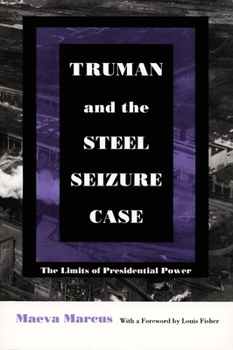Truman and the Steel Seizure Case: The Limits of Presidential Power
(Part of the Constitutional Conflicts Series)
Select Format
Select Condition 
Book Overview
Government seizure of the nation's strikebound steel mills on 8 April 1952 stands as one of President Harry S Truman's most controversial actions, representing an unprecedented use of presidential power. On 8 June 1952 the United States Supreme Court invalidated Truman's order with its monumental decision in Youngstown Sheet and Tube Co. v. Sawyer . The history and significance of this case constitute the subject of Maeva Marcus's meticulously researched, brilliantly analyzed, and authoritative study. From Truman's initial assertion of "inherent" executive power under the Constitution to the High Court's seven opinions, Marcus assesses the influence of the case on the doctrine of separation of powers and, specifically, the nature and practice of executive authority. First published in 1977 (Columbia University Press), and reissued here in paperback with a new foreword by Louis Fisher, this book remains the definitive account of the Steel Seizure incident and its political and legal ramifications.
Format:Paperback
Language:English
ISBN:0822314177
ISBN13:9780822314172
Release Date:March 1994
Publisher:Duke University Press
Length:416 Pages
Weight:1.28 lbs.
Dimensions:1.2" x 6.0" x 9.0"
Customer Reviews
2 ratings
Excellent Recycled Dissertation
Published by Thriftbooks.com User , 20 years ago
This excellent book is a history of Youngstown v. Sawyer, a landmark Supreme Court case on Presidential powers. The case arose when the White House nationalized steel factories in order to block a labor strike that threatened to disrupt steel production during the Korean War. The Supreme Court firmly rejected Truman's claim of an "inherent" Presidential power to seize private property during wartime. Given the extremist constitutional claims made by the current Bush Administration -- including the power to hold American citizens incommunicado for the duration of the (potentially endless) war on terror -- Youngstown remains hugely relevant today. Marcus lays out the political, legal, and foreign policy contexts of Youngstown before delving into the details of the litigation and discussing the constitutional significance of the outcome. Her exposition is workmanlike and methodical, as befits a recycled doctoral dissertation. My only real complaint -- hence the rating of four stars -- is that long sections of the book are little more than summaries of legal briefs and courtroom oral arguments. These could have been cut back. But with that qualification, I would recommend the book without reservation to anyone interested in American constitutional history or the institution of the Presidency.
Parallels to our time?
Published by Thriftbooks.com User , 21 years ago
In an earlier era, steel making was a key strategic industry for the US. Marcus takes us back to 1952 and the tensions of that era. With World War 2 still recently over and the Korean conflict starting up, the international situation looked grave. She walks us through the events that led Truman to take over the steel mills. She marshalls the arguments pro and con for this, that echoed through the nation. A very readable study in the limitations of presidential power. Plus a current reader might be struck by the parallels between Truman's actions and Bush's recent decisions. Both presidents asserted prerogatives that were strenuously opposed by others. Though in retrospect, the Cold War and the then developing Korean War were far deadlier for the US than the current situation, where the US has a unipolar hyperpower advantage.






